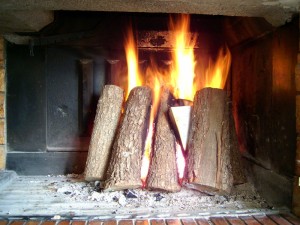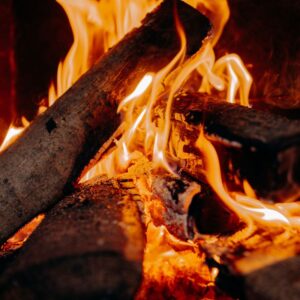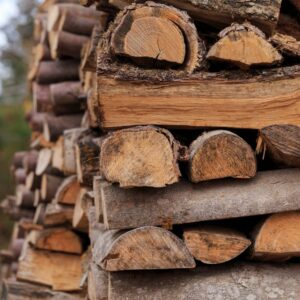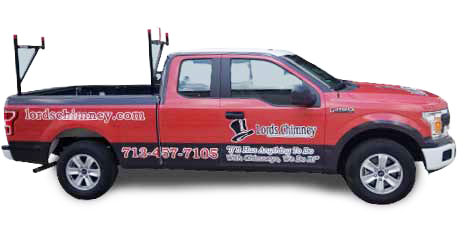During the cold winter months, many families use their fireplaces as a gathering place, sitting together and enjoying the warm flames. But even as your fireplace is keeping you warm inside, the cold temperatures and winter weather could be damaging your chimney outside.
Winter weather conditions are notorious for destroying chimneys and causing existing damage to deteriorate even faster. Snow, ice, and freezing rain can wreak havoc on a chimney system, even one that is in seemingly good condition. Because of this, it is extremely important get a chimney sweep and inspection before the weather gets any colder. This ensures that your fireplace and chimney are safe to use and have not been damaged during the past year.

Water damage
The main way that chimneys are damaged during the winter months is due to water damage. If water is able to enter a chimney structure, it can cause a multitude of issues including rusting pieces of the flue to damaging the masonry. Pinpointing how water is entering a chimney can often be difficult as there are many different places that can cause leaks. The trained technicians at Lord’s Chimney are leak resolution experts who can find and fix the water entry before it causes further damage.
Below are three of the most common causes of water entry in a chimney system:
Damaged chimney cap: Chimney caps cover the top of the chimney itself, keeping the water from rain, sleet, and snow from getting into a chimney. Improperly installed, ill-fitting chimney caps, or damaged chimney caps can allow water to enter the fireplace system. Damage to the chimney cap is often difficult to spot because they cannot be seen from the street.
Leaky flashing: Flashing is the metal band that connects the chimney to the roof structure. Nail holes, loose caulking, poor materials, or general wear and tear can all cause flashing to lose its waterproof seal. Damaged flashing can cause damage to both the chimney and the roof, which is why it is vital that it is properly installed and maintained.
Masonry damage: Although bricks are made to be porous, absorbing too much water can be detrimental. During the freeze/thaw cycle, water in the brick expands as it freezes, causing additional cracks and damage. As it thaws, this creates more space for additional water entry and the cycle continues, eventually causing the brick to break apart and crumble.
Preventing chimney damage
The best way to prevent damage to your chimney during the winter months is through preventative maintenance. An annual sweep and inspection allows any issues to be spotted and resolved before they become major problems. This can save both time and money as well as preserve the safety and structure of your safety.
Lord’s chimney can also apply a special waterproofing to bricks and mortar. The ChimneySaver sealant retains the porous quality of the bricks, letting toxic gasses pass through without letting moisture in. ChimneySaver also allows trapped moisture to evaporate, preventing deterioration, freeze/thaw damage, and the need for expensive masonry reconstruction.
If you have questions about the health of your chimney system, need to schedule an annual sweep and inspection, or would like more information on ChimneySaver waterproofing, contact Lord’s Chimney today!
Fireplaces are a beautiful addition to any room that can provide warmth and ambiance throughout the cold winter months. However, most homeowners pay more attention to what they get out of their fireplaces than what they put in.
What materials you burn in your fireplace can have a direct impact on fireplace performance. In addition, attempting to burn materials that are not meant for residential fireplaces can pose a safety hazard through unmanageable burning or the release of toxic chemicals.

Garbage
More popular in rural areas and communities, burning garbage is not a safe way to dispose of your trash. While there are a growing number of waste-to-energy factories in the United States that burn trash to create useable electricity, these plants are specially designed to filter any toxins or chemicals out of the air supply. Homeowners simply do not have the technology to do this, causing the chemical byproducts of whatever is being burned to enter the atmosphere. Backyard burning has been found to increase the risk of heart disease, aggravate asthma and emphysema, and can also cause rashes, nausea, or headaches.
Green wood
Homeowners should avoid burning green, or freshly cut wood, whenever possible. While green wood will burn, it produces less heat than seasoned firewood because more energy is needed to evaporate the remaining water in the wood itself. In addition, green wood produces large amounts of smoke, which can easily backdraft and fill a room. Finally, burning green wood produces more creosote, a gummy, corrosive, and highly flammable substance that coats the inside of the chimney structure.
Paper products
While burning used wrapping paper or pizza boxes may seem like an easy way to dispose of them, it can actually create a chimney fire. Paper burns extremely quickly, which can cause an enormous increase in the amount of flames if too much is put into the fireplace. These large fires cannot be contained by the firebox, causing flames to travel up the chimney or out into the room.
In addition, most wrapping paper and other printed products are not designed to be burned. While companies based in the United States use approved chemicals and dyes in their paper products, most printed paper produced outside the country does not. Because of this, colored wrapping paper may produce toxic chemicals when burned. Instead of burning them, wrapping paper, cardboard, and other paper products should be recycled or thrown away in the regular trash.
Pretreated wood
After removing old fencing, decking, or playground equipment, many homeowners believe that using the old materials as firewood is an appropriate way to recycle them. However, any wood that has been exposed to glue, paint, stain, varnish, or other chemical treatments should never be burned. The EPA recommends that homeowners “never burn coated, painted, or pressure-treated wood because it releases toxic chemicals when burned.”
Styrofoam
Although Styrofoam burns quickly, putting it into the fireplace is an environmental hazard. When burned, Styrofoam and other packing foams erupt in a cloud of toxic black smoke, releasing chemicals that can damage the nervous system and lungs. In addition, the melted foam particles can stick to the inside of the firebox and chimney structure, creating a future fire hazard if they were to reignite.
Instead, homeowners should only burn properly seasoned firewood in their fireplaces. While different species of trees have different burn characteristics, being dry is by far the most important characteristic of any potential firewood.
While regular cleanings and maintenance are an important part of fireplace upkeep, many homeowners fail to realize that the firewood they use can also impact the performance of their wood-burning appliances. Although the type of firewood you use is ultimately a personal preference, there are many different factors to keep in mind before making a large firewood purchase for the season.
Using unseasoned firewood can trigger lots of issues like excess smoke, less heat, and more creosote accumulation (which can then trigger unpleasant odors and structural issues). All in all, it’s well worth it to either season your own wood pile or take the time necessary to examine the wood you purchase, ensuring it’s adequately dried out and ready to burn.
Hard Woods vs. Soft Woods
All firewood can either be categorized as a hard wood or a soft wood.
 Hard woods: Hardwoods are heavy, dense woods from trees whose leaves change color in the fall. Because of this, hardwoods are known for creating more heat, having longer-lasting fires, and creating more coal beds. The most popular hardwoods are often varieties of elm, birch, maple, and oak.
Hard woods: Hardwoods are heavy, dense woods from trees whose leaves change color in the fall. Because of this, hardwoods are known for creating more heat, having longer-lasting fires, and creating more coal beds. The most popular hardwoods are often varieties of elm, birch, maple, and oak.- Soft woods: Softwoods are most commonly identified by their needle leaves, and includes species such as firs, spruces, pines, and evergreens. Softwoods are quick to ignite and produce more smoke than most hardwoods. Because they burn at a lower temperature, softwoods are often popular choices for fires during the milder temperatures of fall and spring.
Most homeowners favor hardwoods for the bulk of their fires, but many keep a small amount of softwood around to be used as kindling when starting a fire. Likewise, softwoods are extremely popular with those who use their wood-burning appliances for smoking meats due to their strong flavors.
Buying Wood Local: Things to Consider
Another factor to consider when shopping for firewood is where it was grown and harvested. Because tree-killing insects and bacteria can still reside on firewood, transporting wood long distances can expose local trees to dangerous infestations.
As a general rule, homeowners should try to buy firewood that was grown less than 50 miles from their home, while many experts agree that less than 10 miles is ideal.
Packaged, heat treated firewood is generally considered safe to move, and is ideal if you’re looking to purchase wood before an out-of-state camping trip. This wood is usually labeled with the USDA APHIS treatment seal.
Importance of Proper Wood Seasoning
Equally important to the type of firewood you buy is how long it has been seasoned for.
Seasoning is the process during which freshly chopped firewood is allowed to dry when exposed to sun and wind. This practice removes the majority of the water from the wood, reducing the moisture content from as high as 50% to as little as 15%.
Most firewood should be seasoned a minimum of 6 months, while many experts agree that when done properly the seasoning process can take up to a year. Even wood that has been cut from dead or fallen trees still needs to be seasoned.
Why is firewood seasoning important?
 Avoiding Excess Smoke: When fresh wood is used in a fireplace, the flames are forced to use up a ton of energy burning through all that extra water. This triggers smoke to build up and pour out into your living room, quickly turning a cozy evening in into a disaster. Smoke in your home is also an issue when it comes to the health of loved ones. Toxins and fumes from your fireplace should never be inhaled, and they could trigger some serious illnesses.
Avoiding Excess Smoke: When fresh wood is used in a fireplace, the flames are forced to use up a ton of energy burning through all that extra water. This triggers smoke to build up and pour out into your living room, quickly turning a cozy evening in into a disaster. Smoke in your home is also an issue when it comes to the health of loved ones. Toxins and fumes from your fireplace should never be inhaled, and they could trigger some serious illnesses.- Lowering Creosote Accumulation: Burning unseasoned firewood triggers a more rapid accumulation of creosote. Creosote forms as fires burn in your chimney and, when there’s a lot of it, you face some serious risks. Too much creosote can easily cause a chimney fire to form, meaning you’ll be spending a lot of time and money on necessary repair jobs.
- Experiencing More Efficiency: When you burn fresher wood, you’ll experience less heat output from your fire, which isn’t good when you’re trying to save money on your monthly heating bills. While winters aren’t typically too harsh around here, that doesn’t mean we don’t experience lower temperatures. Many invest in a fireplace so that they have a better, more cost-effective way to heat their home when things get cool.
How To Pick Seasoned Firewood
It’s easy to make sure you’re picking the best fuel for your fires this holiday season. Look for logs that are lightweight, dark and split at the ends, and that makes a hollow sound when hit together. These surefire signs indicate that the wood has been adequately dried out – and that your fires will burn much better going forward.
What would should I avoid?
Although it may seem like an excellent way to recycle, old wood from decking, fencing, or playground equipment should not be used as firewood. Unlike regular firewood, these woods are typically treated with stains, paints, or other chemicals to make them more resistant to the elements. Because of this, burning pretreated wood can release a cocktail of poisonous substances into the air.
The Environmental Protection Agency (EPA) recommends to “never burn coated, painted, or pressure-treated wood because it releases toxic chemicals when burned.”
Storing Your Own?
Obviously, the most surefire way to get exactly what you want from the wood you burn is to season your own. Store it in a place that is open, yet protected, such as a wood shed with open sides and a sturdy roof, and let it sit for at least six months before putting it to use. Ensure the pieces are cut short and split on the ends to get things moving faster.
Need Fireplace Maintenance? Call On Us
If your wood pile is ready to go, and you’re ready to put your system to use, call us in for your annual inspection. Our team is CSIA certified and ready to serve, guaranteeing you a safer and better functioning system every single year.
There’s no time to lose – call or reach out online today!




 Hard woods:
Hard woods:  Avoiding Excess Smoke: When fresh wood is used in a fireplace, the flames are forced to use up a ton of energy burning through all that extra water. This triggers smoke to build up and pour out into your living room, quickly turning a cozy evening in into a disaster. Smoke in your home is also an issue when it comes to the health of loved ones. Toxins and fumes from your fireplace should never be inhaled, and they could trigger some serious illnesses.
Avoiding Excess Smoke: When fresh wood is used in a fireplace, the flames are forced to use up a ton of energy burning through all that extra water. This triggers smoke to build up and pour out into your living room, quickly turning a cozy evening in into a disaster. Smoke in your home is also an issue when it comes to the health of loved ones. Toxins and fumes from your fireplace should never be inhaled, and they could trigger some serious illnesses.